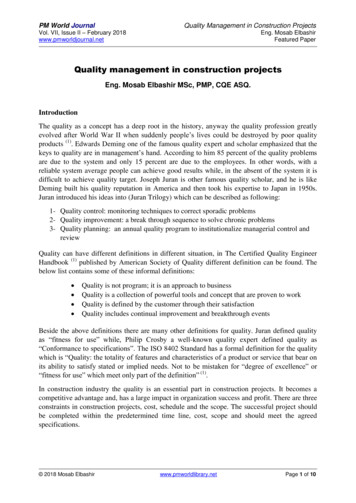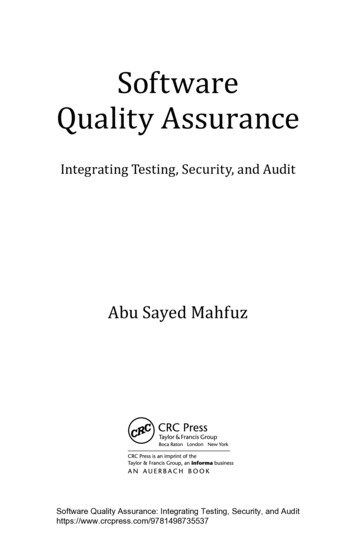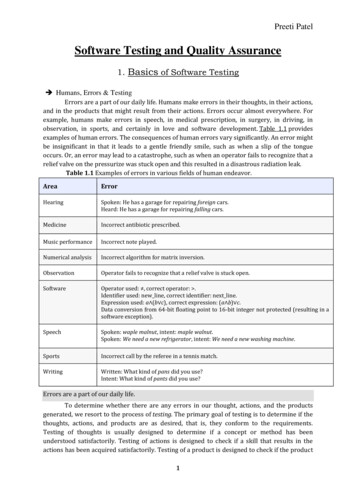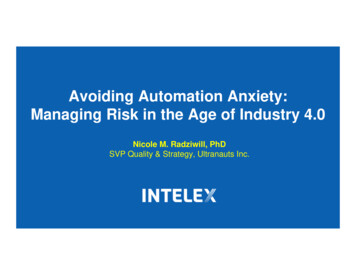
Transcription
3. NATIONALQUALITYSTANDARDAND ASSESSMENTAND RATINGGuide to the National Quality StandardAssessment and rating process
ICONS LEGENDNational Law and RegulationsSections of theEducation and CareServices NationalLaw (National Law) orregulations from theEducation and CareServices NationalRegulations (NationalRegulations).Centre-based serviceAn education andcare service otherthan a family day careservice which includesmost long day care,preschool and outsideschool hours careservices that aredelivered at a centre.Birth to threeChildren birth tothree years of age.OffenceFamily day care serviceAn education andcare service that isdelivered through theuse of two or moreeducators to provideeducation and care tochildren and operatesfrom two or moreresidences.School age childrenIncludes childrenattending schoolin the year beforegrade 1, andabove.ObserveDiscussOffences against theNational Law thatattract a penalty, forexample a fine.SightAuthorised officers willsight documentationprovided as evidenceto support particularpractices at theservice (for example,records of attendance,enrolment records,policies andprocedures, meetingminutes, safetychecklists, newsletters,photos, collections ofchildren’s work anddocumentation ofchild assessments orevaluations).86Authorised officers willobserve what children,families, educators,co-ordinators andstaff members aredoing (for example,engaging in caring,friendly and respectfulinteractions).State iconsWATASNSWSAQLDNTVICACTNational Quality Standard and Assessment and Rating Information that isspecific to a state orterritory.Authorisedofficers willdiscuss why andhow particularpractices occur atthe service, withthe ordinators,family day careeducators,assistants or staffmembers.
NATIONAL QUALITY STANDARDAND ASSESSMENT ANDRATINGCONTENTS1. Introduction 882. Guide to the National Quality Standard 923. Assessment and rating process 3141. Introduction 314Quality Area 1: Educational program and practice 932. Self-assessment and quality improvementplanning 316Standard 1.1: Program 963. The rating system 320Standard 1.2: Practice 110Standard 1.3: Assessment and planning 1234. H ow is an assessment and rating visitconducted? 326Quality Area 2: Children’s health and safety 1385. E xceeding NQS theme guidance 331Standard 2.1: Health 1406. M aking minor adjustments 336Standard 2.2: Safety 1607. Waivers 340Quality Area 3: Physical environment 1768. Evidence of non-compliance 340Standard 3.1: Design 1789. Significant Improvement Required 340Standard 3.2: Use 188Quality Area 4: Staffing arrangements 20210. R eassessment and re-rating at request of theapproved provider 344Standard 4.1: Staffing arrangements 20311. First tier review 346Standard 4.2: Professionalism 21512. Second tier review 351Quality Area 5: Relationships with children 224Standard 5.1: Relationships betweeneducators and children 226Standard 5.2: Relationships between children 238Quality Area 6: Collaborative partnerships with familiesand communities 248Standard 6.1: Supportive relationships with families 250Standard 6.2: Collaborative partnerships 265Quality Area 7: Governance and leadership 278Standard 7.1: Governance 280Standard 7.2: Leadership 298National Quality Standard and Assessment and Rating 87
INTRODUCTIONThe National Quality Standard (NQS) sets a national benchmark for the quality ofeducation and care services and includes seven quality areas that are important tooutcomes for children:QA1Educational program and practiceQA2Children’s health and safetyQA3Physical environmentQA4Staffing arrangementsQA5Relationships with childrenQA6Collaborative partnerships with families and communitiesQA7Governance and leadershipIn each quality area, there are two or three standards. These standards are highlevel outcome statements. Under each standard are elements that describe theoutcomes that contribute to the standard being achieved. Each standard andelement is represented by concepts that support education and care services tonavigate and reflect on the NQS.The quality standards are also underpinned by regulatory standards. The NQS is aschedule within the Education and Care Services National Regulations.See the Guide to the National Quality Standard for more information about theNQS and Operational Requirements for the underpinning regulatory requirements.The rating systemServices are assessed and rated by their regulatory authority against the NQS, andgiven a rating for each of the seven quality areas and an overall rating based onthese results.The process of assessing and rating a service is a combined approach of qualityassurance and regulatory compliance.Quality ratingsThe ratings are: Excellent rating, awarded by ACECQA Exceeding National Quality Standard Meeting National Quality Standard Working Towards National Quality Standard Significant Improvement Required88National Quality Standard and Assessment and Rating Introduction
The quality ratings must be displayed at the service. These ratings are alsopublished on the national registers on the ACECQA website (www.acecqa.gov.au).See more information about how ratings are determined and guidance onExceeding NQS in the Assessment and Rating section.Quality improvementOngoing self-assessment against the NQS drives continuous improvement and isessential to providing quality outcomes for children.Each service must have a Quality Improvement Plan in place (QIP). The QIP identifiesareas for improvement and includes a statement of philosophy for the service.See Assessment and Rating for more information about self-assessment andquality improvement planning.Assessment and rating processAuthorised officers from the regulatory authority will: review service information (compliance history, rating and assessmenthistory) review a service’s QIP visit the service premises to assess and rate the service.See Assessment and Rating for more information.When visiting the service, the authorised officer will collect evidence in thefollowing ways: Observe – what children, families, educators, co-ordinators and staffmembers are doing (for example, engaging in caring, friendly andrespectful interactions) Discuss – why and how particular practices occur at the service, with theapproved provider, nominated supervisor, educators, co-ordinators, familyday care educators, assistants or staff members Sight – documentation provided as evidence to support particularpractices at the service (for example, records of attendance, enrolmentrecords, policies and procedures, meeting minutes, safety checklists,newsletters, photos, collections of children’s work and documentation ofchild assessments or evaluations).Each service is unique and the ways in which the elements and standards are metwill be determined by the service context, including the service environment; theneeds, interests and abilities of the children attending the service; and the needs offamilies and the wider community.National Quality Standard and Assessment and Rating Introduction89
NATIONAL QUALITY STANDARDConceptQA1Educational program and practice1.1ProgramThe educational program enhances each child’s learning and development.1.1.1Approved learning frameworkCurriculum decision-making contributes to each child’s learning and developmentoutcomes in relation to their identity, connection with community, wellbeing,confidence as learners and effectiveness as communicators.1.1.2Child-centredEach child’s current knowledge, strengths, ideas, culture, abilities and interests arethe foundation of the program.1.1.3Program learning opportunitiesAll aspects of the program, including routines, are organised in ways that maximiseopportunities for each child’s learning.1.2PracticeEducators facilitate and extend each child’s learning and development.1.2.1Intentional teachingEducators are deliberate, purposeful, and thoughtful in their decisions and actions.1.2.2Responsive teaching andscaffoldingEducators respond to children’s ideas and play and extend children’s learningthrough open-ended questions, interactions and feedback.1.2.3Child directed learningEach child's agency is promoted, enabling them to make choices and decisions thatinfluence events and their world.1.3Assessment and planningEducators and co-ordinators take a planned and reflective approach toimplementing the program for each child.1.3.1Assessment and planning cycleEach child’s learning and development is assessed or evaluated as part of anongoing cycle of observation, analysing learning, documentation, planning,implementation and reflection.1.3.2Critical reflectionCritical reflection on children’s learning and development, both as individuals andin groups, drives program planning and implementation.1.3.3Information for familiesFamilies are informed about the program and their child's progress.QA2Children’s health and safety2.1HealthEach child’s health and physical activity is supported and promoted.2.1.1Wellbeing and comfortEach child’s wellbeing and comfort is provided for, including appropriateopportunities to meet each child’s need for sleep, rest and relaxation.2.1.2Health practices and proceduresEffective illness and injury management and hygiene practices are promoted andimplemented.2.1.3Healthy lifestyleHealthy eating and physical activity are promoted and appropriate for each child.2.2SafetyEach child is protected.2.2.1SupervisionAt all times, reasonable precautions and adequate supervision ensure children areprotected from harm and hazard.2.2.2Incident and emergencymanagementPlans to effectively manage incidents and emergencies are developed inconsultation with relevant authorities, practised and implemented.2.2.3Child protectionManagement, educators and staff are aware of their roles and responsibilities toidentify and respond to every child at risk of abuse or neglect.QA390DescriptorPhysical environment3.1DesignThe design of the facilities is appropriate for the operation of a service.3.1.1Fit for purposeOutdoor and indoor spaces, buildings, fixtures and fittings are suitable for theirpurpose, including supporting the access of every child.3.1.2UpkeepPremises, furniture and equipment are safe, clean and well maintained.3.2UseThe service environment is inclusive, promotes competence and supportsexploration and play-based learning.3.2.1Inclusive environmentOutdoor and indoor spaces are organised and adapted to support every child'sparticipation and to engage every child in quality experiences in both built andnatural environments.3.2.2Resources support play-basedlearningResources, materials and equipment allow for multiple uses, are sufficient innumber, and enable every child to engage in play-based learning.3.2.3Environmentally responsibleThe service cares for the environment and supports children to becomeenvironmentally responsible.National Quality Standard and Assessment and Rating Introduction
ConceptQA4DescriptorStaffing arrangements4.1Staffing arrangementsStaffing arrangements enhance children's learning and development.4.1.1Organisation of educatorsThe organisation of educators across the service supports children's learning anddevelopment.4.1.2Continuity of staffEvery effort is made for children to experience continuity of educators at theservice.4.2ProfessionalismManagement, educators and staff are collaborative, respectful and ethical.4.2.1Professional collaborationManagement, educators and staff work with mutual respect and collaboratively,and challenge and learn from each other, recognising each other’s strengths andskills.4.2.2Professional standardsProfessional standards guide practice, interactions and relationships.QA5Relationships with children5.1Relationships between educators Respectful and equitable relationships are maintained with each child.and children5.1.1Positive educator to childinteractionsResponsive and meaningful interactions build trusting relationships which engageand support each child to feel secure, confident and included.5.1.2Dignity and rights of the childThe dignity and rights of every child are maintained.5.2Relationships between childrenEach child is supported to build and maintain sensitive and responsive relationships.5.2.1Collaborative learningChildren are supported to collaborate, learn from and help each other.5.2.2Self-regulationEach child is supported to regulate their own behaviour, respond appropriately tothe behaviour of others and communicate effectively to resolve conflicts.QA6Collaborative partnerships with families and communities6.1Supportive relationships withfamiliesRespectful relationships with families are developed and maintained and familiesare supported in their parenting role.6.1.1Engagement with the serviceFamilies are supported from enrolment to be involved in the service and contributeto service decisions.6.1.2Parent views are respectedThe expertise, culture, values and beliefs of families are respected and familiesshare in decision-making about their child’s learning and wellbeing.6.1.3Families are supportedCurrent information is available to families about the service and relevantcommunity services and resources to support parenting and family wellbeing.6.2Collaborative partnershipsCollaborative partnerships enhance children’s inclusion, learning and wellbeing.6.2.1TransitionsContinuity of learning and transitions for each child are supported by sharinginformation and clarifying responsibilities.6.2.2Access and participationEffective partnerships support children's access, inclusion and participation in theprogram.6.2.3Community engagementThe service builds relationships and engages with its community.QA7Governance and Leadership7.1GovernanceGovernance supports the operation of a quality service.7.1.1Service philosophy and purposeA statement of philosophy guides all aspects of the service’s operations.7.1.2Management systemsSystems are in place to manage risk and enable the effective management andoperation of a quality service.7.1.3Roles and responsibilitiesRoles and responsibilities are clearly defined, and understood, and support effectivedecision-making and operation of the service.7.2LeadershipEffective leadership builds and promotes a positive organisational culture andprofessional learning community.7.2.1Continuous improvementThere is an effective self-assessment and quality improvement process in place.7.2.2Educational leadershipThe educational leader is supported and leads the development andimplementation of the educational program and assessment and planning cycle.7.2.3Development of professionalsEducators, co-ordinators and staff members’ performance is regularly evaluatedand individual plans are in place to support learning and development.National Quality Standard and Assessment and Rating Introduction91
GUIDE TO THENATIONAL QUALITYSTANDARDThis chapter provides an overview of the National Quality Standard andincludes examples of practice, programs, environments and policies at themeeting the National Quality Standard level as well as questions to prompteducation and care providers and services to reflect on their quality practice.Examples of what an authorised officer might observe, sight and discuss areoutlined for each of the 40 National Quality Standard elements.Exceeding Themes (see Exceeding NQS Theme Guidance)This chapter also provides guidance to assist services and assessors toconsider whether a service is Exceeding National Quality Standard. Thehigher level of quality that is expected at the Exceeding NQS rating level isdescribed by three Exceeding themes. In determining if a service meets thebenchmark for Exceeding National Quality Standard, authorised officers willconsider whether the three Exceeding themes are demonstrated. ExceedingNational Quality Standard requires a service to go above and beyond whatis expected at the Meeting National Quality Standard level for that standard.This chapter provides an overview of the themes and general indicatorsas well as specific indicators for each of the 15 National Quality Standardstandards.A list of publications for further reading can be found on the ACECQA websiteat www.acecqa.gov.au.92National Quality Standard and Assessment and Rating Guide to the National Quality Standard
QUALITY AREA 1EDUCATIONAL PROGRAM ANDPRACTICEOverviewThe National Quality Standard is linked to two national approved learning frameworksthat recognise children learn from birth. These are: Belonging, Being and Becoming: The Early Years Learning Framework forAustralia (‘Early Years Learning Framework’) My Time, Our Place: Framework for School Age Care in Australia (‘Framework forSchool Age Care’).The approved learning frameworks guide: the development of programs that promote children’s learning anddevelopment the pedagogical practices of educators a planned and reflective approach to assessment and planning for each child.A quality educational program views children as capable and competent learners whohave agency and learn best through a play-based program. The learning frameworksalso acknowledge the importance of intentionally including opportunities for children toprogress towards the learning outcomes (for more information about learning outcomes,see Element 1.1.1.Educational program and practiceIn all settings, the approved provider, nominated supervisor and educational leader areresponsible for ensuring that programs for all children are based on an approved learningframework and delivered in accordance with that framework.Quality Area 1Quality Area 1 of the National Quality Standard focuses on ensuring that the educationalprogram and practice of educators are child-centred, stimulating and maximiseopportunities for enhancing and extending each child’s learning and development.It recognises that a quality program that builds on children’s individual knowledge,strengths, ideas, culture, abilities and interests is likely to have long term benefits forchildren and for the broader society.Play provides a context for learning through which children organise and make sense oftheir social worlds as they engage actively with people, objects and representations (EarlyYears Learning Framework, p. 6).Play-based learning: provides opportunities for children to learn as they discover, create, improvise,test theories and imagine enables expressions of personality and uniqueness promotes positive learning dispositions, such as curiosity and creativity enables children to make connections between prior experiences and newlearning assists children to develop relationships and conceptsNational Quality Standard and Assessment and Rating Guide to the National Quality Standard93
supports a sense of wellbeing and promotes a valuing of diversity (Early YearsLearning Framework, p. 9).In school age care services, the educational program reflects an understanding ofmiddle childhood. The program supports learning through play and leisure wheneducators act with intentionality to nurture the development of life skills andensure that the program complements children’s experiences, opportunities andrelationships at school, at home and in the community.Quality Area 1In all services, educators draw on their pedagogy, knowledge of individualchildren, the approved learning frameworks, the National Quality Standard andthe underpinning law and regulations when designing contextual programs andconsidering practices they will use. With their knowledge of the children andfamilies using the service, and the community in which they are located, educatorsmake informed decisions about how to meet the standards.Educators take a planned and reflective approach to implementing the educationalprogram by using an assessment and planning cycle and engaging with criticalreflection to improve the program and practice. Educators share the program withfamilies and ensure families are informed of their child’s learning and developmentprogress.Services facilitate children’s learning and development through play by providing:Educational program and practice educators with whom children can form attachments educators who use a range of intentional practices and interactions toencourage children’s problem solving and thinking skills welcoming and inclusive learning environments that are flexible,responsive, and foster children’s agency and engagement with the naturaland built worlds access to a range of resources that children can use in a variety of ways toenrich and extend their play uninterrupted and prolonged periods of time to follow their interests.Standards, elements and conceptsQuality Area 1 has three standards that focus on the educational program,educational practice, and assessment and planning for each child’s learning anddevelopment. These standards are crucial to delivering quality outcomes forchildren under the National Quality Framework because: an educational program that is based on an approved learning framework,is child-centred and maximises learning opportunities strongly contributesto children’s development as competent and engaged learners intentional teaching in early childhood settings (and intentionality inschool age settings) is a recognised approach to facilitate each child’slearning and development responsive teaching values, scaffolds and extends each child’s strengths,skills, knowledge, interests and ideas, and child directed learning promoteschildren’s agency critical reflection informs the assessment and planning cycle and94National Quality Standard and Assessment and Rating Guide to the National Quality Standard
drives improvement in program and practice, resulting in continuousenhancements to children’s learning families who are informed about the program and their child’s progressare better equipped to engage with the service and collaborativelymake decisions that strengthen their child’s learning, development andwellbeing.ConceptEducational program and practice1.1ProgramThe educational program enhances each child’s learningand development.1.1.1Approved learningframeworkCurriculum decision-making contributes to each child’slearning and development outcomes in relation to theiridentity, connection with community, wellbeing, confidenceas learners and effectiveness as communicators.1.1.2Child-centredEach child’s current knowledge, strengths, ideas, culture,abilities and interests are the foundation of the program.1.1.3Program learningopportunitiesAll aspects of the program, including routines, areorganised in ways that maximise opportunities for eachchild’s learning.1.2PracticeEducators facilitate and extend each child’s learning anddevelopment.1.2.1Intentional teachingEducators are deliberate, purposeful, and thoughtful in theirdecisions and actions.1.2.2Responsive teaching andscaffoldingEducators respond to children’s ideas and play andextend children’s learning through open-ended questions,interactions and feedback.1.2.3Child directed learningEach child's agency is promoted, enabling them to makechoices and decisions that influence events and their world.1.3Assessment andplanningEducators and co-ordinators take a planned and reflectiveapproach to implementing the program for each child.1.3.1Assessment andplanning cycleEach child’s learning and development is assessed orevaluated as part of an ongoing cycle of observation,analysing learning, documentation, planning,implementation and reflection.1.3.2Critical reflectionCritical reflection on children’s learning and development,both as individuals and in groups, drives program planningand implementation.1.3.3Information for familiesFamilies are informed about the program and their child'sprogress.National Quality Standard and Assessment and Rating Guide to the National Quality StandardQuality Area 1QA1DescriptorEducational program and practiceStandard/Elements95
STANDARD 1.1PROGRAMTHE EDUCATIONAL PROGRAM ENHANCES EACH CHILD’S LEARNING ANDDEVELOPMENT.How Standard 1.1 contributes to quality education and careProgramStandard 1.1Quality educational programs use an approved learning framework to guidecurriculum decision-making and facilitate a shared understanding of children’slearning and development. This enables everyone involved in the service to sharetheir perspectives, understanding of, and support for quality education andcare practices.With support from the approved provider and nominated supervisor, theeducational leader collaborates with educators in designing an educationalprogram that enables educators to work with children and families to achieveoptimal learning and developmental outcomes for children.With guidance from the educational leader, educators: use an approved learning framework to underpin their everyday practice.The framework guides interactions with children and families and providesthe basis for educators’ pedagogical decision-making, including theexperiences that are planned for children and the teaching and learningthat occurs develop the educational program based on their knowledge of eachchild so that the interactions, experiences, routines and events that eachchild engages in are relevant to them, respectful of their background andrecognise and build on their current strengths, abilities and interests ensure that the interactions, experiences, routines and events included inthe educational program maximise opportunities for children’s learning.Questions to guide reflection on practice for Standard 1.1(for all services)Educational program How do we develop our understanding of the approved learningframework that we use in our service to foster learning outcomes for allchildren? How do we support all children to progress towards the learningoutcomes? How do we learn about each child’s knowledge, strengths, ideas, culture,abilities and interests? How do we make decisions about children’s daily experiences androutines, and who is involved in making these decisions?96National Quality Standard and Assessment and Rating Guide to the National Quality Standard
How do we use the learning outcomes to guide our goals and subsequentplanning for individual children and groups of children? How do we plan and implement educational programs that are relevantand engaging for children? How do we ensure that experiences and routines are child-centred ratherthan adult-directed or clock-driven? How do we support every child’s participation in the program? What experiences do we provide for children to work independently andcollaboratively? How do we use conversations and interactions with children to makeroutine times enjoyable and meaningful learning opportunities? How do we ensure that children develop strong attachments and a sense ofbelonging in our service? How do we apply our knowledge of learning and development, and thecontent of the learning framework to this age group? How do we incorporate learning outcomes into leisure opportunities andthe everyday experiences we provide?school agechildren How do we provide problem-solving, inquiry and challenge based learningexperiences for children to support their prior learning? How do we provide a differentiated curriculum that supports children’svarying capabilities, learning styles and interests?Programbirth to threeStandard 1.1 How do we develop a shared understanding of the learning outcomes andtheir importance to families? How do we incorporate the learning outcomes into everyday activities thatchildren experience in the residence?family day care What other activities or experiences can be incorporated into our programto ensure a range of learning opportunities for all children?National Quality Standard and Assessment and Rating Guide to the National Quality Standard97
ELEMENT 1.1.1APPROVED LEARNINGFRAMEWORKCURRICULUM DECISION-MAKING CONTRIBUTES TO EACH CHILD’S LEARNING ANDDEVELOPMENT OUTCOMES IN RELATION TO THEIR IDENTITY, CONNECTION WITHCOMMUNITY, WELLBEING, CONFIDENCE AS LEARNERS AND EFFECTIVENESS ASCOMMUNICATORS.Approved learning frameworkElement 1.1.1National Law and National Regulations underpinningElement 1.1.1National Law &RegulationsSection 51(1)(b) Conditions on service approval (educational and developmentalneeds of children)Section 168 Offence relating to required programsRegulation 73 Educational programWhat Element 1.1.1 aims to achieveAn approved learning framework guides the development of the curriculum atan education and care service and supports curriculum decision-making as anongoing cycle of observation, analysing learning, documentation, planning,implementation and reflection. Curriculum decision-making is guided by theprinciples, practices and learning outcomes of the approved learning framework.This involves educators drawing on their pedagogy and their in-depth knowledgeand understanding of each child.The educational leader and educators use an approved learning framework and theservice philosophy to consider the service’s approach to learning, development andwellbeing, and the way in which these guide everyday practice and development ofthe education program.Approved learning frameworksThe Early Years Learning Framework and the Framework for School Age Care(and other jurisdiction-approved learning frameworks) include principles, practicesand learning outcomes that guide educational leaders and educators in theircurriculum decision-making, and assist them in planning, delivering and evaluatingquality programs in early and middle childhood settings.A learning outcome is a skill, knowledge or disposition that educators can activelypromote in collaboration with children and families. The Early Years LearningFramework and the Framework for School Age Care (Early Years LearningFramework, p. 8; Framework for School Age Care, p. 6) promote five learningoutcomes that are designed to capture the integrated and complex learning anddevelopment of all children. These are:1. Children have a strong sense of identity2. Children are connected with and contribute to their world98National Quality Standa
2. Self-assessment and quality improvement planning 316 3. The rating system 320 4. How is an assessment and rating visit conducted? 326 5. Exceeding NQS theme guidance 331 6. Making minor adjustments 336 7. Waivers 340 8. Evidence of non-compliance 340 9. Significant Improvement Required 340 10. Reassessment and re-rating at request of the











